San Diego Comic-Con 2006
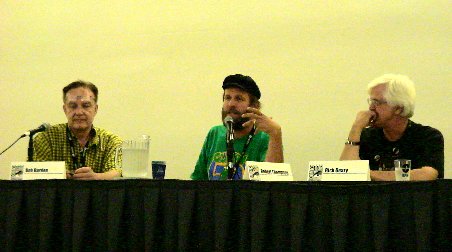
One Gumby to rule them all.
Comic-Con was hot this year, and it wasn’t just the record temperatures. Yes, for those of you from less civilized climes such as Michigan or Boston, the reason all the natives were restless is that we think that weather was hot and muggy.
One of the advantages of going to Comic-Con for the past few years has been the free DVDs of anime trailers. This year’s promises “Babes Blades Blood Beauty” in four complete episodes; but the two that I watched appear to be nothing more than music trailers with anime head shots and some guy dancing in the desert. Would’ve been better synched to Journey.
The free General Jack O’Neill was even less impressive. At first I thought they were advertising a headless zombie Stargate to go with the Zombies freebie. On closer examination, poor Jack’s neck had broken. His head was rolling around the bottom of the plastic bag he came in. Jack also has an odd pair of legs. Instead of bending at the knee, the lower part of his legs rotate left and right. He appears to be the same size as my Flaming Carrot figure, so the Carrot may be getting a walkie talkie and a new weapon.
Judging from Saturday’s exhibit hall, this was the biggest Comic-Con yet. The con’s organizers have always had a problem with crowds but in the past all it has meant is that pre-reg lines would snake all the way around the convention center, seminar lines would get mixed up, and Bruce Campbell would be scheduled for a 25-person room suspiciously filled with cleaning supplies.
Saturday on the exhibit floor was wall to wall people and looked dangerously close to the critical mass necessary for a Who-style stampede. The worst was watching mothers use their children’s carriages as a way to push through the crowd. That’s only going to work when people have room to move. (On another blog I saw them referred to as “stroller nazis”, which is probably an apt description, but that doesn’t stop me from taking advantage of their endangering their children by moving through the crowd in their wake.)
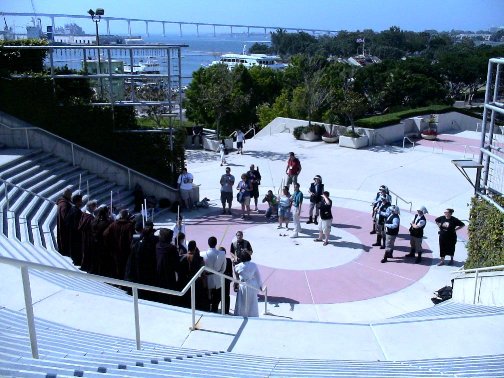
There is no better place than San Diego to execute the Jedi.
Oh, and while I’m in complaint mode: the panel setups seem to assume that nobody in a wheelchair will be presenting. At one panel, two of the presenters had to lift a third presenter, in their wheelchair, up the stairs to the panel platform.
Play it again, Robin
I avoided Hall H this year; I had no desire to spend all day in it, and the only day I might have wanted to was the day Ray Bradbury and Ray Harryhausen were on a panel together at the same time as Kevin Smith. Sorry, Kevin!
The weird highlight of the convention this year had to be the Virgin Comic panel. Deepak Chopra went to Virgin to start a comics company, and Grant Morrison is their star writer. Grant, Deepak, and Deepak’s son Gotham talked about how they want to create comics that will change us all for the better. Grant is likely to be delving deeper into the mythic significance of superheroes. Superheroes teach us that the human story is not about falling down: it’s about getting up again.
The freebie bag contained issue #0 of Virgin Comics, but this was not a Morrison issue. It does offer some lessons from the eternal Devi:
Lessons learned throughout eternity—
One: Never use the front door.
Two: Don’t rely on anyone else to pick you up when you fall.
Three: Don’t let the blood get to you.
Four: No matter what they do, how they do it, or where they do it… don’t let it get personal.
There you go. The secrets of eternity. Grant’s going to have to work hard to improve on that.
Grant Morrison was also at DC’s Big Three seminar on Sunday. Attendance patterns showed classic star psychology: the more popular the star, the later they arrived for the panel. Kurt Busiek arrived about five minutes late, and Grant Morrison another five minutes after that. Of course, most likely this is nothing more than that the more popular a creator is, the more they get accosted in the halls.
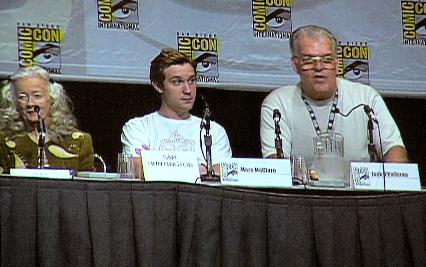
Lois and two Jimmies.
DC took questions from the audience rather than from the microphone, which allowed me to game the system when Grant Morrison said that Batman lives in Hades. Instead of waiting in line, I got my question/comment in right away.
“So then, is Robin Orpheus to Batman’s Hades?”
“That’s interesting… yes.”
Sorry, Robin. When you leave Wayne Manor, don’t look back.
Gumby vs. Flaming Carrot
When it comes to teaching us weird shit in comics, only one person out-weirds Grant Morrison, and that’s Bob Burden. Bob had a new issue of Flaming Carrot done as a photo-comic. And he’s also doing the writing for the new Gumby comic book. Gumby appears to be “Young Flaming Carrot”.
And that’s a good thing.
B-Movie Feast
Friday’s panel with Roger Corman was a fascinating look at the B-movie world, culminating with ex-employee Gale Anne Hurd (also ex-employee James Cameron’s ex-wife) getting into the microphone line and thanking Corman for all he had done for the two of them.
I normally would have considered spending all day Saturday in Hall H, the self-contained mini-con, so as to see Kevin Smith, The Spirit, and the roadside accident that we call Ghost Rider. But there was too much other good stuff going on at the con, and directly opposite Kevin Smith was a panel with Ray Bradbury, Ray Harryhausen, and Forry Ackerman. If I have the opportunity, I try to see Bradbury, and to combine this with Harryhausen, I wasn’t going to miss it. There was, of course, a line but I skipped out of the CAC’s supervillain lovefest a little early and was only one or two blocks away from the door. The three talked about early road trips, seeing King Kong—and enjoying Peter Jackson’s remake—and even had a handful of words about John Whiteside Parsons. The latter name has been popping up randomly in my life ever since I read Strange Angel• a few weeks ago. Babalon may be working yet.
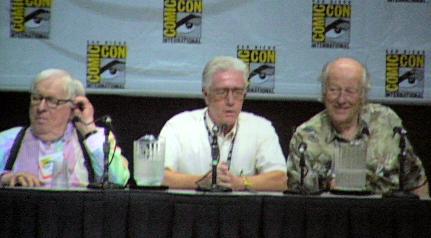
Ray Bradbury, Ray Harryhausen, and Forry Ackerman.
Have I mentioned that the Comic-Con does not do well with lines? At 3:30 on Saturday I went to see how much of a line there was for Bruce Campbell’s 4 PM panel. It wasn’t too bad: it went around one corner, and then wrapped back, and then there was a Con volunteer with a “this is the end of the line, stand here” sign. It seemed pretty likely I’d get in, so I dropped my load of toys and relaxed until whatever was currently in there ended and they let us in.
But the line kept getting longer, and the volunteer kept moving backwards. Eventually, they reached the end of the hallway and had to wrap back around. Which, in and of itself, is not a problem. But the guy wrapped the line into itself. He would have failed horribly at the Snake video game. Sure enough, the line kept getting longer until it reached the other end of the hall, where it probably caused a massive riot. Fortunately I was past the intersection between the bend in the line and the end of the line by about two people, so I didn’t have to punch anybody out.
Part of the reason it was so popular, probably, is that we were promised a “screening of a special feature from the Adventures of Brisco County Jr.” DVD. It was one of those three-five minute “features” of Bruce Campbell reading something from a book. And that’s great, except that the man himself was on the panel a few feet away. But we did get a free blow-up horsie.
The Comic Arts Conference
Every year the CAC gets just slightly more interesting. Every year, it inspires me to start working on my own Alan Moore comparison. Somehow, this year, my desire to write about Alan Moore’s saviors morphed into a desire to survey the ways that role-playing game characters improve themselves. Since that isn’t anything to do with the Comic Arts it’ll just end up on my blog.

I spent almost all Sunday in room 7B, and a good part of Thursday and Saturday, too. (Friday I reserved for buying too much crap on the exhibit floor.)
I missed the presentation on pain and torture in V for Vendetta and the Invisibles, but enjoyed Thursday’s panel on adapting comics into film. Richard Becker rambled a bit, but had some good points about the “crisis of confidence” that results in Hollywood taking superhero works and turning them into something other than superheroes, because that stuff doesn’t work on the big screen. Kate McClancy focussed in on V for Vendetta and how the film ultimately failed to capture the message and spirit of the comic. The film took Moore’s vision of enlightened anarchy and turned it into a paean to unenlightened mob rule.
By comparing the original comic with its film adaptation, this paper discusses how both the narrative and the visual style of the film depart from its source, changing the focus from the acquiescence of the people to their oppression to the government’s creation and maintenance of that oppression. Through its restructuring of Norsefire as an allegory for the Bush administration, the film V for Vendetta allows the voters to remain innocent and complacent, restricting the call for change to larger political formations rather than forcing a recognition of individual responsibility.
Kent Worcester on Saturday had some good thoughts about how New York City affects our vision of the city, at least in comic books. Even places like Washington, DC, that have no skyscrapers, end up looking like New York City in some comics.
On Sunday we examined death. Death has always been a problem in comic books. Part of this is an economic consideration: you can’t kill Superman in a comic book called Superman. Not without bringing the title character back pretty quickly. But this limitation will drastically affect the kinds of stories we get through that genre. José Alaniz said:

This storm trooper is hitting on a civilian while on duty. For god’s sake, man, don’t take off your helmet!
The superhero genre, as Barbier—and all of us—know, is a disability and death-denying representational practice which privileges the healthy, hyper-powered and immortal body over the diseased, debilitated and defunct body. The superhero, by the very logic of the narrative, through his very presence, enacts an erasure of the normal, mortal flesh in favor of a quasi-fascist physical ideal.
This Barbier sounds like one pretty smart cookie. Alaniz goes on to quote anthropologist Ernest Becker:
Man’s body is a problem to him that has to be explained. Not only his body is strange, but also its inner landscape, the memories and dreams. Man’s very insides—his self—are foreign to him. He doesn’t know who he is, why he was born, what he is doing on the planet, what he is supposed to do, what he can expect. His own existence is incomprehensible to him, a miracle just like the rest of creation, closer to him, right near his pounding heart, but for that reason all the more strange.
Sounds like a comic book plot. This was perhaps the most fascinating presentation at the CAC.
The library of unread books
I don’t normally go in for signatures, but at the Comic Book Legal Defense Fund booth (my second stop on Preview night is always the CBLDF) I picked up the 2004 and 2005 Small Press Expo anthologies. When I went to pay for it, the person taking money said “I’m glad somebody’s buying them; I edited the 2005 anthology.”
I hope people are buying them, these anthologies are great introductions to new creators. Anyway, I asked if she’d sign it, and she did. I told her I’d have to get the other two editors to sign it to complete the set, but of course I didn’t. The only other time I’ve asked for a signature (for myself) was several years ago when I purchased a hardcover of Arkham Asylum for a mere $5. At the exact moment I handed the fin over the PA announced that Grant Morrison was signing upstairs. It was a very Morrison moment. Afterwards, I thought that a $5 Arkham Asylum would make a great gift so I ought to buy a few more. I couldn’t find the booth again. And this was well before the huge expansion of the exhibit hall.
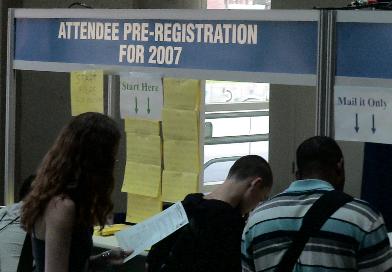
When the signs are too confusing, add more signs with tiny text!
I know I saw a copy of The Man Who Would Be October in the same pile.
For the past several years, the highlight of comic-con for me has been finding new comics that have been recommended to me in the previous year or so. I don’t take the time to head to the comic book store every week now, and because I don’t there isn’t much point in going to the comic book store at all. So I wait until the collected editions come out at comic-con.
I’ve been told that I need to read Warren Ellis’s Transmetropolitan for some time now, and I finally picked up the first volume. It was good enough that when I found the rest of them for $10 a volume I picked up all of them… except for, annoyingly, volume 2, which was unavailable anywhere that I looked.
I also picked up a few volumes of Ellis’s Planetary•. It looks worthwhile. Alan Moore’s Promethea• is quintessential Moore, examining the workings of reality by way of the basic superhero myth. As expected in a Moore book, there is a lot of concern for the details. Weeping Gorilla is hilarious; and the background interactions between the Five Swell Guys are great.
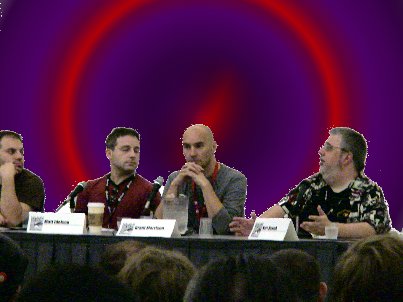
If I go to my happy place, perhaps they’ll all disappear.
Grant Morrison hasn’t been resting since the last time I bought comics. We3• is just plain strange. It looks like it ought to have been a one-hour television special for the Hallucinogenic Broadcasting System. I enjoyed it, anyway. Seven Soldiers is a new take on the Seven Soldiers of Victory from DC, and, at least through volume 3 is pretty damn good. Klarion the Witchboy, I don’t know, Morrison has to stop giving stuff like this away. This “team that’s not a team” reads a lot like what the Defenders were meant to be.
Speaking of Moore, DC is cashing in on his previous association with them by publishing DC Universe: The Stories of Alan Moore•. It includes the legendary Whatever Happened to the Man of Tomorrow, which I’ve never read until now, and a few others.
If Marvel Comics wants to cash in on brilliant writers who have previously worked with them, they should look at Steve Gerber’s work. I’ve finally finished my collection of the Sons of the Serpent and Brotherhood of the Badoon arcs from the early Defenders•. The Sons of the Serpent storyline was especially memorable. I’d read most of them when I was younger, but only owned one of them myself. The rest were friends’ copies and have long since disappeared. That storyline stands up reasonably well today. I’ll bet there are a lot of little things like that scattered throughout Gerber’s association with Marvel.
- Rewards and improvement in Dungeons & Dragons
- Kill monsters. Take their stuff. How has character improvement in D&D changed over the years? This article in the RPG experience series looks at changes in experience point acquisition from early D&D through later versions of the game and later games by the authors.
- Comic Book Legal Defense Fund
- The CBLDF is “dedicated to the preservation of First Amendment rights for members of the comics community.”
- Small Press Expo: Michael W. Zarlenga
- “SPX has a unique format of only selling exhibitor space to independent publishers and not to retailers. This provides a very intimate and friendly atmosphere for our creators and fans to mingle. At the same time, there's a wide array of programming for all to enjoy.”
- Planetary Vol. 1: All Over the World and Other Stories•
- “Clever retellings of primal comics myths are interlaced with X-Files-esque secret government tales… the stories are both broad and deep, exploring a web of conspiracies and shadowy superheroes that manipulate and ‘protect’ our world.”
- Promethea (Book I)•
- A vaguely Wonder Woman-esque superheroine (sorry, “science hero”) examines the magical workings of the world and our creativity. Watch for the little things; “Weeping Gorilla” had me laughing throughout.
- DC Universe: The Stories of Alan Moore•
- “Superheroes tales told with such wit and imagination that they reach all the promise the genre offers.”
- We3•
- An experimental band of cybernetic animals gets loose, and tries to find their way home. From Grant Morrison, making it even weirder than it sounds.
- Seven Soldiers of Victory (Volume 1)•
- “The initial stories of the first four soldiers belonging to a team that’s not a team: the Shining Knight, from King Arthur’s Round Table; the Guardian, an ex-cop become a newspaper's in-house crime-buster; Zatanna, a magician who’s lost her powers; and rebellious Klarion the Witch Boy, an otherdimensional goth.”
- Essential Defenders (Volume 2)•
- “Collects Defenders #15-39, Giant-Size Defenders #1-5.” That would include the entire Sons of the Serpent storyline and the Brotherhood of Badoon.
- Snake video game at Wikipedia
- “The player controls a long, thin creature, resembling a snake, which roams around on a bordered plane, picking up food (or some other such item), trying to avoid hitting its own tail or the ‘walls’ that surround the playing area.”
- Strange Angel: The Otherworldly Life of Rocket Scientist John Whiteside Parsons•: George Pendle (paperback)
- “A self-taught chemist with an affinity for explosives, Parsons teamed up with Frank Malina and the rest of the so-called Suicide Squad in the dangerous quest for dependable rocket technology. Parsons became cofounder of the Jet Propulsion Laboratory and an aerospace company, but he was also a member of the licentious Church of Thelema, a ludicrous invention of the English mystic Aleister Crowley.” I read the hardcover, but it looks like only the paperback is currently available.
- V for Vendetta: A Love Story
- The Wachowski brothers took a great book but failed to overcome typical Hollywood cliches, making V for Vendetta little more than a love story for terrorists.
More comic conventions
- Comic-Con Dining
- If you’re looking for late-night dining in San Diego, go to www.DiningAfterMidnight.com. Only places open after midnight get on the list.

It’s a far-gone lullaby, sang many years ago. Mama, mama, many worlds I’ve come since I first left home.